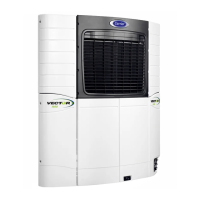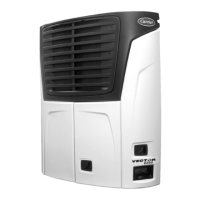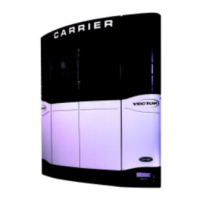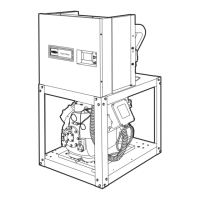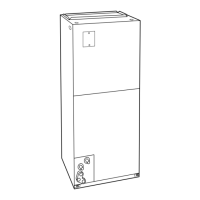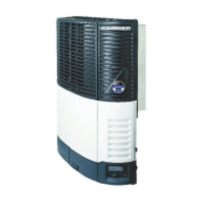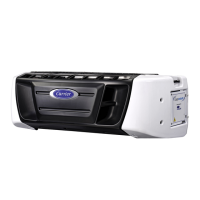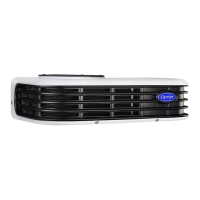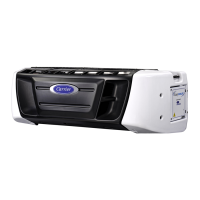62-61753-21
4. Engine Coolant Warm-Up
The engine will run in low speed until the coolant is
above 50°C (122°F).
5. Door/Remote Switch Configuration
If the Door/Remote Switch Configuration is set for low
speed, the engine will run in low speed when the
door/remote switch is open/active.
6. Auto Silent Mode
If the engine is restarted from a Start/Stop off cycle for
any reason except a Start/Stop Parameter Override
Temperature the engine will operate in low speed until
the overriding condition is met
7. Low Speed To High Speed Delay
The compressor must operate for 2 minutes before
transition to high speed is allowed.
The time value entered in the High Speed Delay
Configuration must be expired before transition to
high speed is allowed.
The time value entered in the Low Speed Startup
Minutes Functional Parameter (for Start/Stop or
Continuous) must be expired before transition to
high speed is allowed.
8. Operation With A Frozen Setpoint
If in Start/Stop mode with a setpoint in the frozen
range (-12°C [+10.4°F] or below), and the minimum
run time has expired, and the refrigerated com-
partment temperature is not at setpoint, the engine
will transition to high speed.
If setpoint is in the frozen range, and the refrigerat-
ed compartment temperature is below setpoint, the
engine will transition to low speed.
9. Low Suction Pressure
The microprocessor monitors the signal provided by
the Suction Pressure Transducer. If the suction pres-
sure falls below -0.14 bar (-2psig) for more than 20
seconds, the engine will operate in low speed for a
minimum of 5 minutes, then remain in low speed until
the suction pressure is greater than -0.14 bar (-2psig).
10. Operation With A Perishable Setpoint
If in Start/Stop Operation with a setpoint in the per-
ishable range (above -12°C [+10.4°F]) and all con-
ditions for an OFF Cycle have been met except for
setpoint, the engine will operate in high speed to
pull down to setpoint and cycle off quicker.
NOTE
Generally, the unit will go into an off cycle from
high speed when this condition occurs. How-
ever, if one of the required conditions for shut
down is no longer met during this time, (for
example, the battery voltage drops below the
configured value, or the charging amps in-
crease above the configured value, or the en-
gine coolant temperature drops below 122°F
(50°C), the engine may return to low speed
operation until the shut down condition is satis-
fied, then shut down from low speed.
If in Continuous Operation with a setpoint in the
perishable range (above -12°C [+10.4°F]) and the
High Speed Pulldown Configuration is set to YES,
the engine will operate in high speed until the re-
frigerated compartment temperature is within
±0.2°C (0.4°F) of setpoint.
11. Product Shield
If the ProductShield High Air Configuration is set to
ON, the engine will operate in high speed whenev-
er the ambient air temperature is outside the tem-
perature range selected.
If the ProductShield Delta-T Configuration is set to
ON, the engine will operate in high speed whenev-
er the Delta-T is greater than the selected value.
(Refer to Section 4.6.3 for more information on
ProductShield.)
4.7.4 Operating Mode Overrides
With the complex control systems in use with the
LogiCOLD Microprocessor, there are many different
reasons - other than the number of degrees the refrig-
erated compartment temperature is away from setpoint
- that the refrigeration system may be operating in
Economized Mode, Standard Mode or Bypass Mode.
Operating Mode Overrides are:
1. High Discharge Pressure
If the microprocessor is requesting Economized Mode
with discharge pressure above 30.2 bar (444.4 psig)
or under a condition where the the compressor suction
modulating valve (CSMV) has throttled more than 30%
in an attempt to control rising discharge pressure, the
system will be transitioned to Bypass Mode.
2. High Generator Current
If the system is operating with high generator current
the microprocessor will throttle the compressor suction
modulating valve (CSMV) in an attempt to reduce the
load. If additional current reduction is required the
microprocessor will transition from Economized Mode
to Standard Mode or Standard Mode to Bypass Mode
as required to prevent the engine from stalling. As
current is reduced, the microprocessor will reverse
these steps to provide maximum allowable capacity.
This action is called "staging".
Downshift Staging: If the compressor suction modulat-
ing valve (CSMV) has throttled more than 30% of its
available position due to high current and the absolute
value of the compressor suction modulating valve
(CSMV) position is less than 20%, operation will transi-
tion from Economized to Standard Mode or from
Standard to Bypass Mode.
Upshift Staging: Bypass to Standard Mode: The up-
shift will occur when the generator current is less than
the allowed maximum generator current - (1 amp + an
upshift offset). The upshift offset is 0.5 amps X the
number of failed upshift attempts.
Upshift Staging: Standard to Economized Mode: The
upshift will occur when the generator current is less
than the allowed maximum generator current -
(1.5 amp + an upshift offset). The upshift offset is
0.5 amps X the number of failed upshift attemps.

